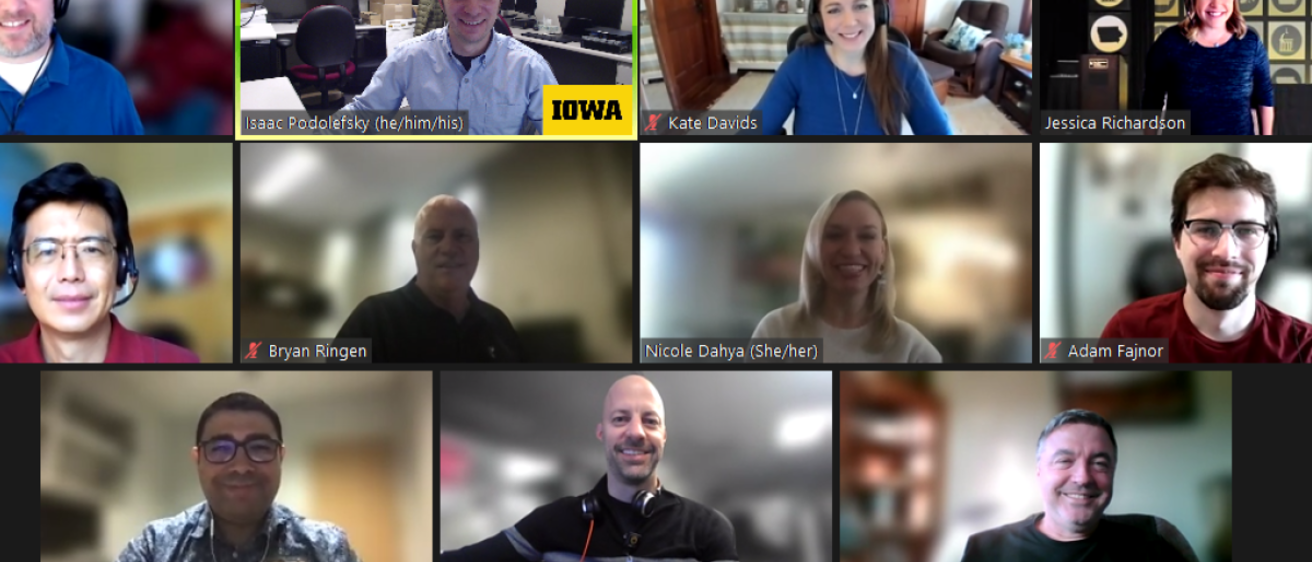
Breadcrumb
Shaping the future of work
With the pandemic as an impetus, information technologists at the University of Iowa are adapting to and supporting a variety of work arrangements, including on-campus, hybrid, or fully remote positions.
Some critical IT roles—such as hands-on technical support and installation and maintenance of equipment and key IT infrastructure—continue to be performed on campus. Other roles can be done effectively from afar with the help of video conferencing and collaboration tools such as Zoom and Microsoft Teams. In Information Technology Services (ITS), about 25% of staff are always on campus, 25% are fully remote, and half split their time between home and university workspaces.
After a successful pilot of the various work arrangements, university administration gave ITS permission to make remote and hybrid work part of its normal operations. The business rationale for this decision included significant demand and competition for IT professionals.
The IT organizations at Iowa State University and the University of Northern Iowa have similar proportions of remote and hybrid workers, and a host of private-sector technology companies across the nation offer the option to attract talent. The technology consulting and research firm Gartner predicts that 74% of IT workers will have a hybrid or remote work arrangement after the pandemic.
“We know hybrid and remote work arrangements are important to employees and believe this is a positive step forward in creating a work environment that is responsive to both their needs and those of the university,” says Associate Vice President and Chief Information Officer Steve Fleagle. “By providing a wider range of work arrangements, we hope we can provide flexibility and support work-life balance while continuing to meet the ever-growing IT needs of the university. Moving in this direction will help us retain existing staff, improve our ability to attract new staff, and reduce expenses.”
Convenience for customers
ITS has closely monitored customer impacts throughout the shift in work arrangements, and the results are positive.
Surveys of customer experiences with the ITS Help Desk showed healthy increases in customer satisfaction. Participation in training offered by the Office of Teaching, Learning, and Technology (OTLT) increased by 78 percent from 2019, when it was all in-person, to 2021, when it was offered online (from 203 to 362 people). Additionally, feedback on quality from attendees in the online events is equal to in-person events. OTLT also offers one-on-one consultations for instructors to improve their teaching and classroom experience. Beginning July 1, 2021, instructors were given a choice of online consultation via Zoom, or a face-to-face meeting. Thirty-four out of 40 (85%) chose online over in-person.
“We always want to meet faculty and instructors where they are at and make it as easy as possible for them to take advantage of our services,” says OTLT Senior Director Maggie Jesse. “The reasons cited for preferring virtual sessions included the increased efficiency of not having to spend time traveling to and from a meeting and the high-quality engagement that online consultations offered.”
Engaging employees
The convenience of online events and collaboration hubs has also contributed to keeping the IT community connected across a variety of work arrangements.
OneIT held its first online Tech Forum for university IT professionals in 2021, drawing 450 attendees per day across two half-days of programming. Participation in project roadmap review sessions is better than ever, and employees have launched interest-specific spaces in Microsoft Teams to simulate water cooler chat. A conversation partners program is being piloted to foster informal conversation and build relationships.
Monthly online CIO Listening Posts continue to attract strong crowds of 300 to 350 as a venue for employees to ask questions and cover topics such as health and safety, campus updates, and employee recognition. To date, 41 forums have been held, where nearly 350 staff questions were answered and almost 700 “shout outs” were delivered for a job well done.
Furthering the research mission
ITS has partnered with researchers in the Tippie College of Business on a series of surveys to understand employee experiences in various work arrangements as it continues to evolve its organization.
“Our ultimate goal is to help the university leadership design the work and workplace better by informing the decision-makers and leadership about employee experience under the current pandemic situation,” says doctoral student Seung Whan Ryu, who works with Assistant Professor of Management and Entrepreneurship Beth Livingston on the study.
Participation in the surveys has been high—70 percent—and the researchers have been exploring areas such as productivity, satisfaction with work arrangements and location, likelihood to consider leaving, compensation, and experiences with virtual meetings, looking at differences across work arrangements.
New tools and training
With the shift in work arrangements, ITS leaders and a sub-team of staff developed guidelines for staff and supervisors. They outlined expectations, technology and environmental requirements, definitions of work arrangements and which positions are eligible for each, and new employee onboarding.
Trainings have been offered for facilitating hybrid meetings and using the virtual collaboration tool Miro, and ITS is piloting “hotel spaces” that can be reserved when hybrid or remote staff come to campus.
"We are still near the beginning of this journey and there is more to learn about hybrid and remote work,” Fleagle says. “Now that we know it's long-term, we can devote more energy to optimizing our entire environment, working with partners, customers, and co-workers on campus, to make sure it is effective for everyone. We will also need to look at our processes and our space needs to see where those need to evolve.”